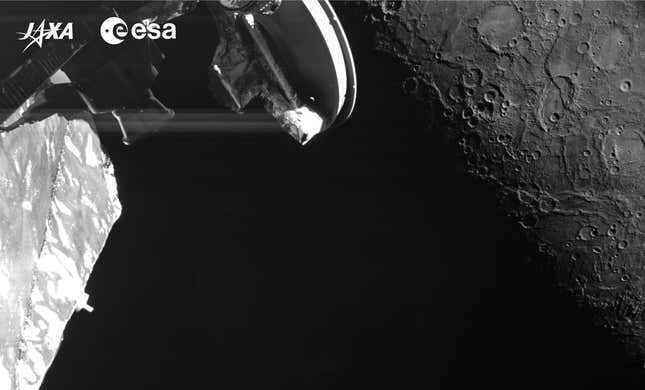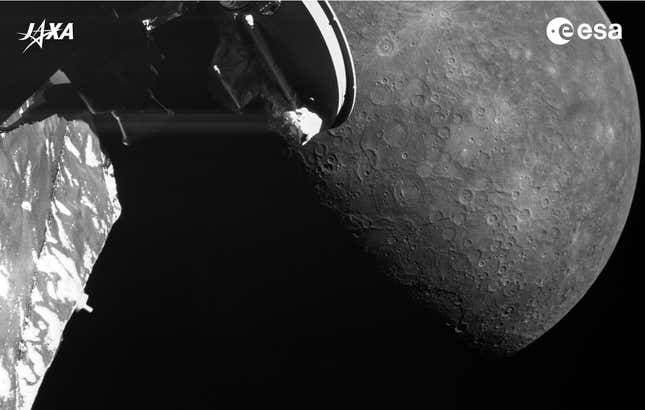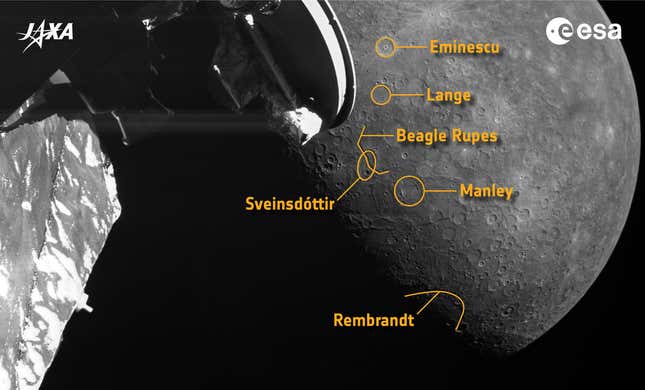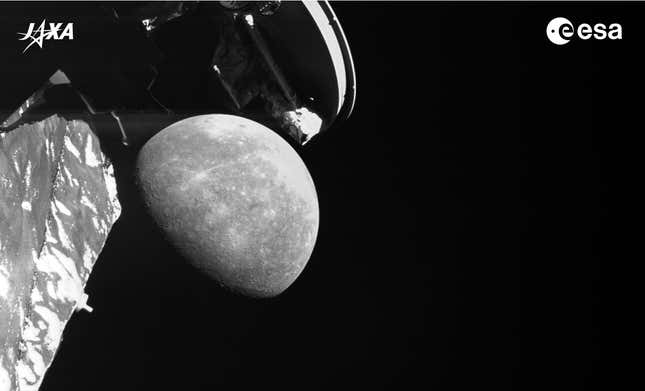Mercury Probe Captures Stunning New Images During Latest Flyby
A probe is familiarizing itself with the closest planet to the Sun, gearing up to explore Mercury’s heavily cratered surface. The BepiColombo mission recently captured stunning new images of Mercury during a close flyby, which resulted in the naming of an impact crater after a pioneering Jamaican artist.
BepiColombo, a joint mission by the European Space Agency (ESA) and the Japan Aerospace Exploration Agency (JAXA), made its closest approach to Mercury on Monday June 19 at 3:34 p.m. ET. The spacecraft was at a distance of around 146 miles (236 kilometers) above the surface of Mercury at its closest, allowing it to capture intimate images of the solar system’s tiny-but-mighty planet.
The spacecraft’s monitoring camera 3 snapped tens of images of Mercury, which were transmitted to Earth overnight. On Tuesday, ESA released three images that capture BepiColombo approaching the rocky planet before departing its side for the third time.
Indeed, this marked BepiColombo’s third of six gravity assists, whereby the spacecraft uses Mercury’s gravity to slow down as it positions itself to enter the planet’s orbit. The spacecraft is actually a pair of orbiters stacked on top of one another, each equipped with their own science instruments to help uncover Mercury’s mysteries.

In this first image, BepiColombo approaches Mercury’s nightside, in which the Sun’s rays begin to illuminate the tiny planet. The photo was captured some 12 minutes after the spacecraft’s closest approach, according to ESA. The rugged surface topology is clearly visible, including Mercury’s many impact craters.


As more of Mercury’s features made their way out from the shadows, a large 135 mile-wide (218 kilometers) peak-ring impact crater appeared to the right of the spacecraft’s antenna. An annotated image (above) shows the location of the newly named crater, along with several others.
“During our image planning for the flyby we realised this large crater would be in view, but it didn’t yet have a name,” David Rothery, a member of the BepiColombo imaging team, said in ESA’s statement. As a result, the crater was assigned the name Manley by the International Astronomical Union in honor of one of the most profound Jamaican artists, Edna Manley.
The crater’s basin floor has been flooded with smooth lava, indicative of Mercury’s volcanic history. BepiColombo is set to further explore Manley Crater during its mission.

BepiColombo’s brief rendezvous with Mercury had to, unfortunately, come to an end, and the pair will not meet again until the spacecraft’s fourth gravity assist on September 5, 2024.
In the meantime, the spacecraft has a tough challenge ahead as it gears up for its upcoming “thrust arcs” sequence in August. During a six-week period, BepiColombo will gradually fire up its electric propulsion system to brake against the powerful gravitational pull of the Sun.
“We are already working intensively on preparing for this long thruster arc, increasing communications and commanding opportunities between the spacecraft and ground stations, to ensure a fast turnaround between thruster outages during each sequence,” Santa Martinez Sanmartin, ESA’s BepiColombo mission manager, said in the statement.
The Sun’s gravity is what makes Mercury so hard to reach, with BepiColombo being only the third spacecraft to travel to the solar system’s most inner planet. The mission, which launched in 2018, is scheduled to finally settle in Mercury’s orbit in 2025. When it does so, BepiColombo will divide into two orbiters: ESA’s Mercury Planetary Orbiter, which will scan the planet’s surface and interior, and JAXA’s Mercury Magnetospheric Orbiter, which will study the planet’s magnetic field.
For more spaceflight in your life, follow us on Twitter and bookmark Gizmodo’s dedicated Spaceflight page.
A probe is familiarizing itself with the closest planet to the Sun, gearing up to explore Mercury’s heavily cratered surface. The BepiColombo mission recently captured stunning new images of Mercury during a close flyby, which resulted in the naming of an impact crater after a pioneering Jamaican artist.
BepiColombo, a joint mission by the European Space Agency (ESA) and the Japan Aerospace Exploration Agency (JAXA), made its closest approach to Mercury on Monday June 19 at 3:34 p.m. ET. The spacecraft was at a distance of around 146 miles (236 kilometers) above the surface of Mercury at its closest, allowing it to capture intimate images of the solar system’s tiny-but-mighty planet.

The spacecraft’s monitoring camera 3 snapped tens of images of Mercury, which were transmitted to Earth overnight. On Tuesday, ESA released three images that capture BepiColombo approaching the rocky planet before departing its side for the third time.
Indeed, this marked BepiColombo’s third of six gravity assists, whereby the spacecraft uses Mercury’s gravity to slow down as it positions itself to enter the planet’s orbit. The spacecraft is actually a pair of orbiters stacked on top of one another, each equipped with their own science instruments to help uncover Mercury’s mysteries.

In this first image, BepiColombo approaches Mercury’s nightside, in which the Sun’s rays begin to illuminate the tiny planet. The photo was captured some 12 minutes after the spacecraft’s closest approach, according to ESA. The rugged surface topology is clearly visible, including Mercury’s many impact craters.


As more of Mercury’s features made their way out from the shadows, a large 135 mile-wide (218 kilometers) peak-ring impact crater appeared to the right of the spacecraft’s antenna. An annotated image (above) shows the location of the newly named crater, along with several others.
“During our image planning for the flyby we realised this large crater would be in view, but it didn’t yet have a name,” David Rothery, a member of the BepiColombo imaging team, said in ESA’s statement. As a result, the crater was assigned the name Manley by the International Astronomical Union in honor of one of the most profound Jamaican artists, Edna Manley.
The crater’s basin floor has been flooded with smooth lava, indicative of Mercury’s volcanic history. BepiColombo is set to further explore Manley Crater during its mission.

BepiColombo’s brief rendezvous with Mercury had to, unfortunately, come to an end, and the pair will not meet again until the spacecraft’s fourth gravity assist on September 5, 2024.
In the meantime, the spacecraft has a tough challenge ahead as it gears up for its upcoming “thrust arcs” sequence in August. During a six-week period, BepiColombo will gradually fire up its electric propulsion system to brake against the powerful gravitational pull of the Sun.
“We are already working intensively on preparing for this long thruster arc, increasing communications and commanding opportunities between the spacecraft and ground stations, to ensure a fast turnaround between thruster outages during each sequence,” Santa Martinez Sanmartin, ESA’s BepiColombo mission manager, said in the statement.
The Sun’s gravity is what makes Mercury so hard to reach, with BepiColombo being only the third spacecraft to travel to the solar system’s most inner planet. The mission, which launched in 2018, is scheduled to finally settle in Mercury’s orbit in 2025. When it does so, BepiColombo will divide into two orbiters: ESA’s Mercury Planetary Orbiter, which will scan the planet’s surface and interior, and JAXA’s Mercury Magnetospheric Orbiter, which will study the planet’s magnetic field.
For more spaceflight in your life, follow us on Twitter and bookmark Gizmodo’s dedicated Spaceflight page.
